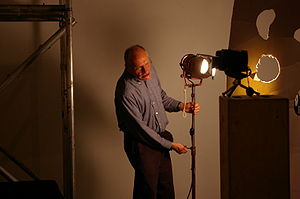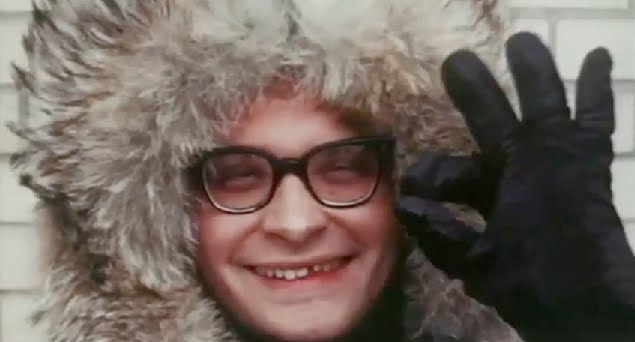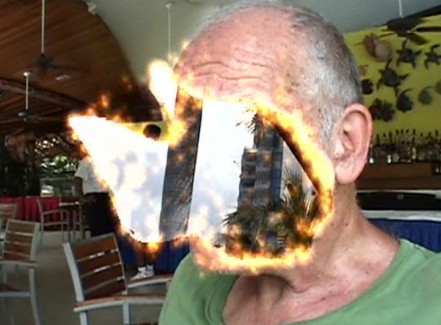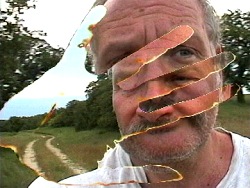
George Kuchar’s Videos: Excrements of Time by Steve Reinke
George Kuchar and his twin brother Mike began making small gauge films as teenagers in the Bronx. These films clumsily reconstruct and restage the tawdry melodrama and cheesy horror of Hollywood B film. I can’t resist listing some titles: The Wet Destruction of the Atlantic Empire (1954), The Thief and the Stripper (1959), I Was a Teenage Rumpot (1960), Pussy on a Hot Tin Roof (1961), Lust for Ecstasy (1963) and Hold Me While I’m Naked (1966). Nine of these films have recently been recipients of National Film Preservation Foundation monies–along with Kenneth Anger’s Rabbit Moon, they are the first experimental works to be honored.
These early works have earned their place in film history on a number of fronts. They offered a way through the impasse of the psychodrama (which was the then-dominant mode of first-person artists’ film) by stressing the performative over more essentialist notions of subjectivity. In this, they also became the prototype for certain strains of queer cinema. Against prevailing notions of high art, they maintained a relationship to popular culture (particularly the most debased genres) that was parallel rather than antagonistic, demotic rather than elitist (to say the least). Whole strains of underground/experimental cinema were spawned by the Kuchar brothers’ early work. Two names in particular are frequently cited: Andy Warhol and John Waters.
David James, in his indispensable Allegories of Cinema: American Cinema in the Sixties, writes about this early Kuchar work in relation to pop art (which it anticipated and influenced) as a critique of authenticity:
…first, authorship is inscribed not in the narrative or the imagery so much as in the self-consciously domestic manufacture; second, in the quotation of industrial motifs, affection is indistinguishable from a self-conscious distancing that suggests but always short-circuits explicit criticism; and third, signification hovers between the generic stock and the hypothetical real life outside the film that the diegesis invokes but never asserts… The films always reserve their own seriousness at some level, and so always preserve some degree of thematic urgency. The oscillation between lampoon and emulation strategically preempts the unequivocal affirmation of either; the authentic can be present in neither art nor nature, film nor life, but only glimpsed, fragmentarily, in the practice that slips desperately between them.
What is this practice, this apparatus, that has the amoeba-like ability to slip desperately between film and life, which allows one to be on all sides of the camera simultaneously? Not film, and not merely camp, or some kind of queer performativity, but specifically: Video.
As camcorders became available in the mid 1980s, George began making videos: an outpouring of work that thankfully continues unstaunched. A few hundred titles, often more than a dozen a year, ranging from pop song to epic feature film length. They arrive by the U.S. Mail, often in groups of two or three, at the Video Data Bank in Chicago. In the envelope is usually a hand-written note containing tape descriptions. This is his description for The Cellar Sinema (1994), selected partly for its brevity: “A descent into the blackness of the projected image and the curators who flick the switches and grease up all moveable parts for hot action when the lights go out.” The condensed (one could say hard-boiled) hyperbolic language, the humor, which is coarse and clever in equal parts, and the sexualizing of the cinematic apparatus are all typical.
Although his work has been widely screened and celebrated, (Kuchar is famous and beloved in the independent media world) it has been slow to get the critical attention it merits. Gene Youngblood’s re-assessment of Kuchar’s work is typical. Youngblood was an appreciate fan from the beginning. Writing about the films in 1968, he detected something serious in the apparently light-hearted work, and compared Kuchar to Bunuel, though finding it necessary to note that Kuchar was, of course, inferior. Today he unequivocally states, “George Kuchar is one of the great artists in the history of the moving image.” I agree.
Some impediments to it being taken “seriously”:
1. The body of work is so large, critics can’t easily digest (let alone watch) all of it.
2. Individual titles often rely on their relationship to his body of work for their complexity to be appreciated and their impact to be felt. They are not autonomous, but part of a larger—epic and ongoing—project.
3. As George is the fundamental presence in almost every title, (simultaneously author, narrator and subject), the work can seem all the same, just George being George. The restlessly protean nature of the work—it adopts and abandons strategies with nonchalance—often goes unrecognized
4. George’s persona is essentially comic; he’s a clown, melancholy but affable. And clowns are always slow to get respect.
5. The work is unabashedly homemade, celebrating the technological possibilities (and reveling in the limitations) of consumer equipment. Despite the consummate skill Kuchar employs in all aspects of production, by industrial standards it is amateur rather than professional.
6. Rather than sticking to camp strategies that are safely ironic or satiric, Kuchar frequently deploys a scatological kitsch viewers may find indefensibly puerile. (For a brilliant defense of this aspect of the work, see Gene Youngblood’s writing on Kuchar, at this time only available with the VDB box set.)
Kuchar’s video work can be grouped into two categories: student collaborations and solely-authored works. Kuchar has taught production for many years at the San Francisco Art Institute, as well as frequent visiting artist gigs at other American institutions. Steve Seid describes the student collaborations as “wildly ambitious, jerry-rigged epics that slash and burn their way through the Hollywood lexicon.” Kuchar himself describes the process in 1989’s 500 Millibars to Ecstasy, which documents a visit to University of Wisconsin, Madison: “… like sleep-away camp with a lust-crazed zombie seeking unholy couplings with the gas- and bug-free residents of College Town, U.S.A.” (Kuchar’s comic persona allows for unrequited yearning, but not unrestrained coupling: the wished-for or attempted seductions of our horny pedagogue always go awry.) These works desperately attempt to maintain their narrative drive against out-of-control libidinal drives. But flaming creatures must flame (or pretend to flame, however ineptly), so coherent story-telling becomes secondary. (The meticulous lighting and framing, the rag and bone shop props and costumes are, of course, never secondary.)
George’s solely-authored works constitute the bulk of his production. As soon as he picked up a video camera in 1985, it seems as though Kuchar had decided to de-emphasize the autonomy of individual titles in favor of an expansive, continuing corpus of work that does not have fixed boundaries. I think of these works as components of one large project—not an autobiography, but a journal studded with self-portraits and portraits of others (often with little distinction between the two).
The camcorder allowed Kuchar to exceed the limits of filmic autobiography and documentary. Steve Seid observes: “…the camcorder allowed Kuchar to be everywhere at once. He was behind the camera cajoling innocent bystanders, before the camera pouring out heart-rending confessions about spent youth and intestinal juices, and somewhere in-between adding campy layers of in-camera observation.”
It isn’t that Kuchar is physically everywhere at once (as important as his presence is) but that he simultaneously occupies three usually separable positions: author, narrator and subject. This is particularly apparent in his groundbreaking works of the mid to late 80s, which are constructed through in-camera editing. “In-camera editing” is really a term from film. It refers to works that are shot sequentially and not subsequently edited. In films that employ in-camera editing, we are assured that each shot is profilmically consecutive, that the events of the second shot occurred prior to the events of the third shot. Video, with its instant playback and erasibility, can inscribe time with a greater degree of flexibility and ambiguity. George’s use of in-camera editing (we really should have a different term for it as it so fundamentally differs from in-camera editing in film) involves taping long shots, rewinding the tape, and inserting new material. In this manner George creates a kind of eternal present: events and his commentary on these events are seamlessly woven together in a way that makes George always present in the text (as subject and narrator) and separate from it, as an authorial presence providing commentary (author and narrator). If autobiography is necessarily retrospective, Kuchar developed techniques that make it simultaneously immediate and retrospective.
Video Album 5: The Thursday People (1987) was the first of Kuchar’s videos to come to prominence, and justifiably so. I have never seen a better—or more moving—depiction of mourning as a social process. It documents, without sentimentality, the final days of underground filmmaker, and ex-Kuchar student, Curt McDowell, as well as the days following his death. It is more straightforward in its approach than many other titles: Kuchar announces scene changes, and we can easily follow the chronology of events (which include screenings, a Sunday outing with his friend Panos to a Greek festival, etc.). But, as always with Kuchar, it would be a mistake to think the work is not meticulously constructed, or merely left to the contingencies of everyday occurrences. Throughout the video, a brittle cheerfulness is maintained through the suppression of other emotion. Relentlessly optimistic in social situations throughout the video, Kuchar in the final scenes uses his mother as a foil. George retrieves pictures of McDowell’s funeral (which is not otherwise depicted in the video) from his (McDowell’s) underwear drawer to show her. His mother, seeing them, weeps restrainedly. When George says he looked good, she replies, “He didn’t look too good to me.” The price of this transgression of (necessarily hypocritical) social niceties: an outpouring of emotion. In his final comments, Kuchar alternates between maintenance of an optimistic social order (“He looked kind of good in the coffin, sort of like an old Scottish gentleman.”) and pessimistically humorous comments aimed generally at humanity (“The ravenous, the ravishing, and the ravaged.”). This split occurs throughout Kuchar’s work. It would be simplistic to suggest that the truth lies in his a- (or possibly anti-) social pessimism rather than his social optimism. Though Kuchar’s work relentlessly interrogates the price of socialization/civilization, he is not a romantic searching to free himself.
In Cult of the Cubicles (1987), one of Kuchar’s New York videos, George celebrates his 45th birthday (“Thanks for bringing us on the Hell planet, Mom.”) and argues with his mother about his dirty underwear, which he holds up to the camera saying: “Dear Lord, I’m sorry I fight with my mother, but my underwear is my business, and the business of my audience. It ain’t that yellow.” Why is it our business and not Mom’s? This is not confession, but mock confession, sleazy entertainment masquerading as confession. The mock confession can never be submitted to the institutions of power, or it will become an actual confession and the carnivalesque joy will be drained out of it. The physical and moral abjection would then be subject to various regimes of control and correction. Mom must never know. This is the nature of disgust, of the scatological, in Kuchar’s work: it side-steps confession and avoids control. The clown may take responsibility for his own melancholy, but for nothing more.
Also in 1987—annus mirabilis—the incredibly sad Rainy Season. Here, Kuchar uncharacteristically drops his affable comic persona. It is one of the few tapes in which he has sex; alas, his lover falls into a deep post-coital depression and George is powerless to help him. In Rainy Season, Kuchar’s mastery of in-camera editing reaches a new level of precision. The climax of the tape is a conversation that is constructed by dropping in new sections, often in mid-sentence. George responds to finding a pony-tail elastic band his sad lover left behind. The slashes represent edit points:
Lynn: No one would dance with me so I had to dance with the furniture.
George: That’s very interesting, because many times I have sex with the furniture. It’s safe.
Lynn: All you have to do is be yourself.
George: But I am myself and that’s the problem. It’s safe sex, but it’s sick. / Oh Lynn, what has become of us. Look here. This held / the hair of someone who shared in my darkness, but in a way the furniture’s so much more / stable and well-constructed. We biological specimens do / damage to our brain cells and then I’m hated by everyone / from dope addicts to students.
For his weather diary series, Kuchar annually visits Reno, Oklahoma in tornado season and “storm squats” in a motel. Weather Diary 3 (1988) is all about anticipation: waiting for the fulfillment of desires that will never be fulfilled. Our protagonist, George, both wants and doesn’t want. He wants to experience extreme weather, but only at a safe distance, and mediated by television. Likewise, his sweetly unrequited desires for the boy next door are as touching as the boy is unwitting. Any desires that can be easily realized are consigned to the realm of disgust: hot dogs, pizza, and the resulting feces. The nature of desire—to be present as long as its object remains unattainable—finds a profound correlative in Kuchar’s use of video. He is in the moment, documenting and enacting desire and also outside of the moment, posterior to it, able to provide commentary. But he is also able to be anterior to the moment. In one scene he masturbates in the shower. This long shot is identified as the present. The cut-aways (a guy mowing the lawn, etc.) are added later in the process to humorously suggest what Kuchar might have been thinking as he jerked off. But as he shakes the semen from his hand, he hums the music that moments later occurs extra-diegetically. If the cut-aways are posterior, the humming is anterior, anticipatory. Kuchar pops in and out of time, the profilmic time of the documentary event. At the moments when this time-popping happens, humor is often produced. After the shock of laughter comes a certain deep and ordinary sadness.
Both Point ‘n’ Shoot (1989) and A Rocky Interlude (1990) feature George’s beefcake friend John. In Point ‘n’ Shoot, named after the cheap Vivitar camera, John is the happy object of George’s (as well as the video camera’s and the Vivitar’s) gaze as he lounges in the Jacuzzi. This relationship, of model to artist, seems simple and ideal, as far as the cameras are concerned. Things get rockier in A Rocky Interlude. George’s crotch grab is intercepted, and they squabble when hiking. But slow motion shots of a shirtless John reveal that as long as everyone stays on the appropriate side of the camera, everything’s fine.
A solution to this model/photographer problem is reached in Snap ‘n’ Snatch (1990): everyone is simultaneously photographed and photographing. Briskly edited to a cheesy, though compelling, pop song (that plays twice) the video is an innocent pansexual orgy in which everyone gets to be on both sides of the camera.
Scarlet Droppings (1990) riffs on a letter to a boy written on the back of a girl’s class photo George finds among the autumn leaves in Normal, Illinois. A masterful use of repetition—both visually and in the spoken letter—builds a nostalgic melancholy that George undercuts in his final Schopenhauerian monologue:
Just take it for what it is. You know it’s not like a person. Maybe you’re better off with a person, maybe not. They both bite your head off. You know the way animals are. You just have to accept them. You can’t make any kind of judgments. They’re run by instincts. You can’t expect them to behave morally. It likes to eat, it likes to have sex and it likes food. Don’t expect too much from a thing like that. Just take it for what it is.
This article was commissioned for Video Data Bank’s 5 DVD box set entitled The World of George Kuchar.






